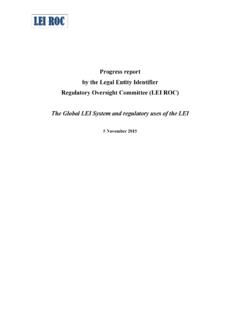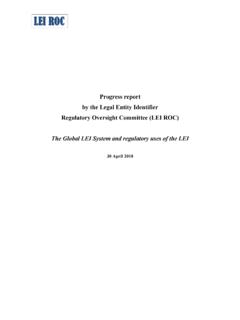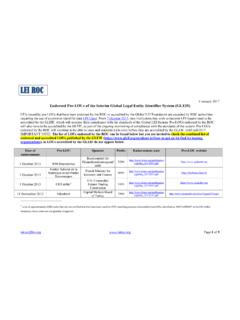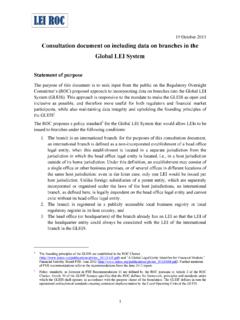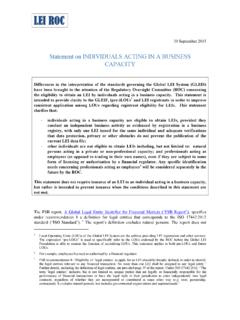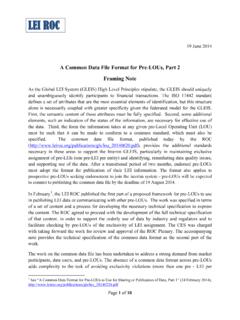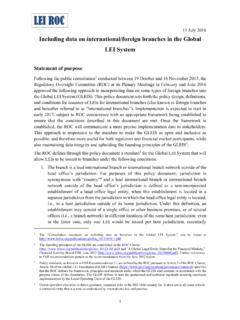Transcription of LEI ROC
1 LEI ROC 19 November 2018 Second Consultation Document on Fund Relationships in the Global LEI System Executive summary The present report proposes a limited update to the way relationships affecting funds are recorded in the Global LEI System (GLEIS), with the objectives of making sure that the implementation of relationship data is consistent throughout the GLEIS and providing a means to facilitate a standardized collection of fund relationship information at the global level. These objectives are being pursued by: (i) providing a definition for each fund relationship and (ii) better aligning the data structure with what is done for direct and ultimate accounting parent entities as defined in the LEI Regulatory Oversight Committee (LEI ROC) report of March 20161. Following the first consultation on the policy document, the LEI ROC brought improvements to the definitions and decided to keep the collection of fund relationships optional in some cases where the fund relationships are not required to be reported, while encouraging reporting.
2 A significant proportion of entities that have a Legal Entity Identifier (LEI) are investment The report proposes to replace the current optional reporting of a single fund family relationship as part of Level 1 (reference data of the entity) with the following relationships, as part of Level 2 data (relationship data): Fund Management Entity relationship, proposed to be defined as a legal entity is considered as the main management entity of a fund when it is legally responsible for the constitution and operation of the fund. Such responsibility will include the day-to-day management of a fund's investments and management of a fund s risks, or the appointment of others for that purpose. In the latter case, the entity to which these functions may have been delegated is not considered to be a Fund Management Entity. This latter exclusion is due to the fact that the data collection is not designed to capture the entity in charge of managing the investments of a fund, but to improve the identification of funds.
3 Respondents noted that capturing all entities involved in the management of the same fund would require a more detailed description of the nature of these other relationships, rather than an unstructured listing of any kind of delegated services to the fund. 1 See LEI ROC publication Collecting data on direct and ultimate parents of legal entities in the Global LEI System Phase 1 , March 2016, 2 Based on the entity category field, some 8% of LEI records with an issued status were classified as funds as of 19 November 2018. 2 Umbrella Structures relationship, proposed to be defined as a legal entity with one or more than one sub-funds/compartments where each sub-fund/compartment has its own investment objectives, separate investment policies and strategies, segregation of assets, separate investors and which has segregated liability between sub-funds/compartments.
4 This would cover a range of cases, such as UCITS compartments in the EU, series funds and insurance company separate account in the non-investment management funds in Japan, where the trustee would be the umbrella structure. To the extent possible, these different situations would be identified through the legal form of the entity, which is another data element recorded in the GLEIS. Master-Feeder relationship, proposed to be defined as a relationship, where a Feeder Fund is exclusively, or almost exclusively, invested in a single other fund ( , EU UCITS), or several funds that have identical investment strategies ( some alternative investment funds in the EU) referred to as a Master Fund (or Master Funds). It was clarified that this covers only cases where this relationship is organized in the legal documentation of the feeder fund, and does not cover relationships where a fund s assets are invested in multiple other funds (fund of fund structure).
5 In line with responses to the first consultation, the LEI ROC recommends eliminating the proposed generic category Other Fund Family (except for past records) and not including any additional relationships at this stage. The LEI ROC proposes that the collection of these relationships in the GLEIS would be optional, except: If the relationship is mandated to be reported and publicly available in the relevant jurisdiction AND if the LEI is mandatory for the related entity in the relevant For the relationship between an umbrella structure and a sub-fund or compartment. The optional approach was chosen because it is difficult to have meaningful, workable definitions that would cover all possible fund legal structures in all jurisdictions around the globe. There were also concerns that the mandatory reporting of these relationships could make registrations more costly and complicated, and would go against the priority objective of increasing LEI coverage.
6 To address the drawback of optional reporting, the LEI ROC proposes to flag whether applicable relationships have been reported. The ROC also envisages to give the option to report that a fund is self-managed4, as this would help distinguish from cases where the fund has not opted to report the relationship. 3 For example, starting in 2018, the SEC will require LEIs on Form N-CEN for any registered fund in a Master-Feeder relationship. However, the SEC does not currently require a fund s adviser (Fund Management Entity) to have an LEI. (See Investment Company Reporting Modernization Release Nos. 33-10231 (2016)). 4 See section IV for a discussion of self-managed funds. 3 To address the other drawback that relationship data would not be available in all cases to improve the quality of information on funds the LEI ROC publishes for consultation, in an annex to this report, Guidelines for the registration of Investment Funds in the GLEIS.
7 This consultation document was developed by the LEI ROC under its Committee on Evaluation and Standards (CES).5 The purpose is to seek input from the public on the design of a process for collecting data on the relationships of funds within the GLEIS. Your responses to the questionnaire annexed to this document are invited by 14 January 2019 and will inform the final version of the policy framework that the ROC will approve for implementation by the Global LEI Foundation (GLEIF).6 Implementation would not take place before January 2020. 5 The ROC was established in January 2013 to coordinate and oversee a worldwide framework of legal entity identification, the Global LEI System. The ROC was established on the recommendation of the Financial Stability Board and its Charter was endorsed by the Group of 20 (G-20) nations in November 2012. G20 Leaders at their Los Cabos summit in June 2012 encouraged global adoption of the LEI to support authorities and market participants in identifying and managing financial risks.
8 (More on ). 6 The GLEIF is in charge of defining, in consultation with the ROC and other relevant stakeholders, operational and technical standards for the GLEIS necessary for consistent implementation in a federated system, or respecting specific schemas or transmission protocols. These operational and technical standards are in particular defined in the Master Agreement between the GLEIF and LOUs (more information on the Master Agreement and Global LEI legal framework can be found here: ). This Master Agreement defines the minimum provisions of the contracts between LOUs and the legal entities for the issuance and maintenance of LEIs. 4 Table of Contents Introduction .. 5 Section I Objectives of the data collection .. 5 1. Improve the current collection of fund relationships .. 6 2. Uses of fund relationship information .. 6 3. Funds represent a significant proportion of entities with an LEI and are generally not captured by the accounting consolidation parent relationships already collected in the GLEIS.
9 7 Section II - Definitions .. 8 1. Definition of Fund Management Entity .. 9 2. Definition of Umbrella Structure .. 11 3. Definition of a Master-Feeder relationship .. 14 4. Whether an other fund family relationship should be created .. 15 Section III - Whether entity related to a fund should always be represented with an LEI, or whether the current situation where a name is recorded without an LEI could be continued. 16 Section IV - Extent to which fund relationships should be required by the GLEIS in order to obtain or maintain an LEI .. 18 1. Optional approach to reporting, subject to exceptions .. 19 2. Cases where fund relationships would be subject to mandatory recording in the GLEIS .. 19 3. Mitigating the limitations of the optional approach .. 20 Section V - Verifications to be conducted by LOUs concerning fund relationships and the source for verification.. 22 Section VI Representation of fund relationships in the GLEIS.. 23 Section VII - Other fund relationships.
10 24 Annex 1 .. 26 Draft guidelines for the registration of Investment Funds in the GLEIS .. 26 1. Address and jurisdiction of an investment fund .. 26 2. Name of a sub-fund .. 28 3. Different Registration Authorities and validation levels.. 30 4. Pools of assets .. 32 Annex to the guidelines: examples .. 33 Annex 2: Summary of responses received to the public consultation .. 42 Annex 3: LEI ROC Working Group on Fund relationships Members List .. 44 Annex 4: Questionnaire for the public .. 45 5 Introduction The LEI is a 20-character reference code to uniquely identify legally distinct entities that engage in financial transactions. Each LEI is associated with reference data including the name and legal address of the entity. LEIs are issued and managed by a network of independent operators federated by the GLEIF applying the rules of the GLEIS under the oversight of the LEI ROC. The LEI ROC gathers over 90 official sector bodies from more than 50 countries.

